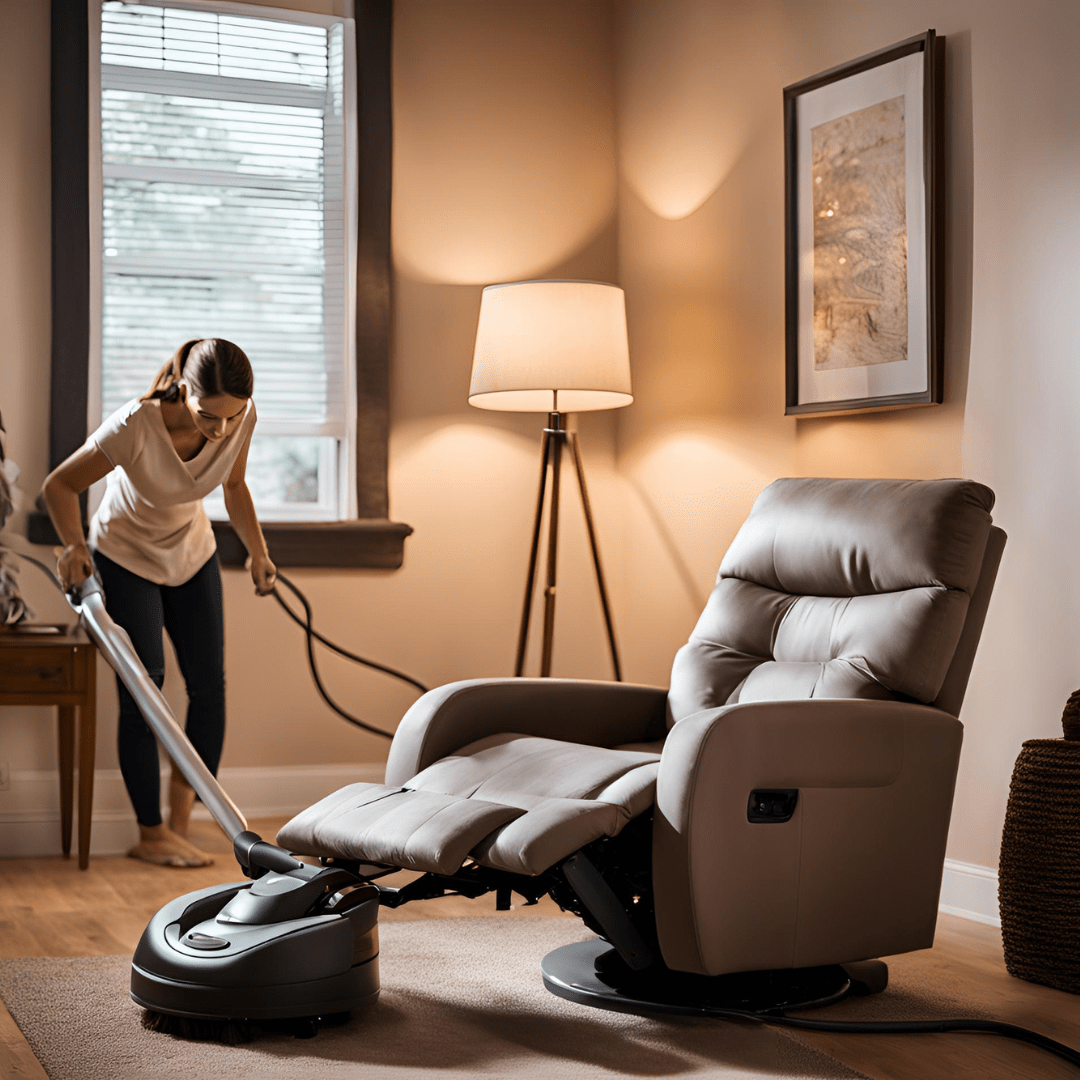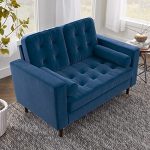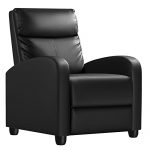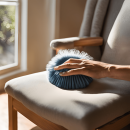
How Do clean a recliner chair!!
First vacuum it to remove dust, then spot clean stains using a suitable upholstery cleaner. Ensuring your Recliner Chair remains clean and fresh requires a straightforward approach, combining regular dusting with prompt stain removal.
A clean recliner enhances the comfort of your living space and prolongs the furniture’s life, making maintenance an essential aspect of household care. Recliner chairs, a staple in many homes for relaxation, are prone to accumulating dirt, spills, and dust over time.
Proper cleaning maintain to your recliner contributes to a healthier environment by minimizing allergens. The process involves simple steps that can easily integrate into your regular cleaning routine, ensuring your recliner stays in top condition.
Whether dealing with fabric, leather, or synthetic materials, the key is to use the right cleaning products and methods to avoid damage. Keeping your recliner clean enhances its appearance and functionality, making it a cozy spot for your home.
Types Of Recliner Chairs
Keeping a recliner chair clean ensures both comfort and longevity. But it’s important to know your chair’s material before you begin. Let’s dive into the types of recliner chairs and the best ways to keep them spotless.
Fabric Recliners
Fabric recliners are cozy and can come in textures and colors. They are popular for their comfort and the warmth they provide. However, fabric can be a magnet for dust and spills. Here’s what you need to know:
- Vacuum regularly to remove loose dirt and dust.
- Check the manufacturer’s label for cleaning instructions.
- Use a gentle, water-based cleaner for most fabric types.
- Avoid harsh chemicals that might damage the fabric.
- A fabric cleaner or a homemade solution, of water and mild detergent can be used.
Leather Recliners
Leather recliners add a touch of elegance to any room. They are durable and easier to clean than fabric. However, leather requires special care to maintain its look and feel. Here are some tips:
- Use a soft, dry cloth to dust the surface.
- For a deeper clean, use a leather conditioner or cleaner.
- Wipe spills immediately to prevent stains.
- Keep out of direct sunlight to avoid fading.
- Never use abrasive cleaners or alcohol-based products.
Vinyl Recliners
Vinyl recliners are great for those who want a leather look without the maintenance. Here’s how to care for vinyl:
- Wipe with a damp cloth for daily cleaning.
- Use mild soap and water for more thorough cleaning.
- Stay away from solvents and abrasive cleaners.
- Apply a vinyl protector to extend its life and keep it looking new.
How To Clean A Fabric Recliner Chair
Wondering how to clean a fabric recliner? It’s simpler than you might think. Follow these steps for a fresh and clean chair:
- Remove loose cushions and vacuum the entire chair.
- Mix a solution of warm water and gentle detergent.
- Dip a soft cloth into the solution and wring it out.
- Blot the fabric gently, don’t rub to avoid pushing the dirt deeper.
- Use a fresh, damp cloth to remove soap residue.
- Dry with a towel and let air dry completely before use.
For persistent stains, consider a fabric cleaner or an upholstery cleaning machine. Always test a small, inconspicuous area first to ensure there’s no discoloration or damage.
Gathering Supplies
Gathering the right supplies before cleaning your recliner chair is crucial. This ensures you’re fully prepared to tackle dirt and stains effectively. Let’s break down what you need into categories: cleaning solutions, tools, and protective gear.
Cleaning Solutions
Choosing the correct cleaning solution depends on your recliner’s material. Here’s a quick guide:
- For fabric recliners: Mix warm water with a few drops of mild detergent.
- For leather recliners: Use a solution of equal parts water and white vinegar.
- For synthetic materials: A mild detergent solution works well.
Always test your solution on a small, unseen part of the recliner first. This ensures it won’t damage the material.
Tools Needed
Having the right tools on hand makes cleaning your recliner easier. Here’s a list of essentials:
- Soft cloths: For applying solutions and drying surfaces.
- Soft-bristled brush: Helps lift dirt from fabric textures.
- Vacuum with an upholstery attachment: Removes dust and loose debris.
- Bucket: To mix cleaning solutions.
Remember, using gentle tools prevents damage to your recliner’s material.
Protective Gear
Protecting yourself is just as important as protecting your recliner. Here’s what you need:
- Gloves: Protect your hands from cleaning solutions.
- Apron: Keeps your clothes clean.
- Goggles: Optional, but recommended if using strong solutions.
Wearing protective gear keeps you safe and prevents accidents during the cleaning process.
Preparing The Area
Cleaning a recliner chair starts with a crucial step: preparing the area. This ensures a safe, efficient, and thorough cleaning. Let’s set the stage for a spotless recliner without any mess or stress.
Clear Surrounding Space
Before diving into the cleaning process, clear the space around your recliner. A clutter-free area prevents accidents and ensures easy access to the chair from all angles. Follow these simple steps:
- Remove any cushions or accessories from the chair.
- Shift nearby furniture to create ample working space.
- Ensure all small objects and tripping hazards are out of the way.
A clear space protects your belongings and helps you spot dirt and stains on the chair that might go unnoticed.
Place Drop Cloth
Next, safeguard your flooring from drips and spills by placing a drop cloth. Choose a cloth that’s large enough to extend a few feet beyond the chair’s base. Here’s a quick guide:
| Material | Benefits |
|---|---|
| Cotton | Absorbs spills, washable |
| Plastic | Waterproof, disposable |
| Canvas | Durable, reusable |
Secure the drop cloth’s edges with tape to prevent it from slipping. Now, you’re ready to tackle those stains without fear of damaging your floors.
Ventilation Tips
Good ventilation is key when cleaning any furniture piece. It helps in drying and prevents fumes from cleaning products. Here are effective ways to ventilate:
- Open windows to allow fresh air to circulate.
- Turn on fans to speed up the drying process.
- Keep doors open to prevent stale air pockets.
Proper ventilation ensures a healthier environment and a quicker return to enjoying your refreshed recliner.
Removing Loose Debris
A recliner chair invites you to relax, regular use can lead to a build-up of crumbs, dust, and pet hair. Cleaning a recliner chair starts with an essential first step: removing loose debris. This simple task sets the stage for a deeper clean, ensuring your favorite spot remains fresh and inviting. Let’s dive into the best ways to clear away the unwanted mess.
Vacuuming Techniques
Vacuuming is a powerful way to collect dirt from your recliner. Here are some tips to do it effectively:
- Use a handheld vacuum for hard-to-reach spots.
- Attach a brush nozzle for gentle fabric care.
- Employ a crevice tool to dig into the recliner’s nooks.
Start with the large, flat areas and move into the folds and gaps. Remember to lift cushions to suck up hidden crumbs. A regular vacuum schedule keeps the recliner free from debris build-up.
| Area | Tool | Frequency |
|---|---|---|
| Seat and Back | Upholstery Attachment | Weekly |
| Armrests | Brush Nozzle | Bi-Weekly |
| Under Cushions | Crevice Tool | Monthly |
Brush Options
Brushes are great for lifting dirt from recliner fabrics. Here’s how to use them effectively:
- Choose a soft-bristled brush for delicate materials.
- A stiff-bristled brush works well for durable fabrics.
- Always brush in the direction of the fabric grain.
Gentle brushing weekly can prevent dirt from embedding into fibers. Tackle stubborn areas with a brush after vacuuming for the best results.
| Fabric Type | Brush Type | Action |
|---|---|---|
| Leather | Soft-bristled | Gentle Circular Motions |
| Suede | Specialized Suede Brush | Light Strokes |
| Upholstery | Stiff-bristled | Short, Quick Strokes |
Importance Of Dusting
Dusting is key in keeping a recliner clean. It’s not just about looks; dust can cause allergies. Use a microfiber cloth to trap dust effectively. Wipe down all surfaces weekly to reduce allergen build-up. Focus on areas that touch the skin, like armrests and headrests. Regular dusting extends the life of your recliner and keeps it comfy for years to come.
- Dust before vacuuming to catch fallen particles.
- Use a damp cloth for sticky or greasy spots.
- Avoid harsh chemicals that can damage fabrics.
| Surface | Tool | Method |
|---|---|---|
| Wooden Areas | Microfiber Cloth | Dry or Slightly Damp |
| Fabric | Microfiber Cloth | Dry Dusting |
| Metal Parts | Clean Cloth | Wipe with Appropriate Cleaner |
Cleaning Fabric Recliners
A comfy fabric recliner is the go-to spot for relaxation in many homes. But daily use can lead to spills, stains, and a build-up of dirt. Keeping it clean ensures your cozy nook remains inviting. Let’s explore how to return your fabric recliner to its former glory without damaging its delicate materials.
Spot Cleaning Stains
Stains are inevitable, but quick action can prevent them from becoming permanent fixtures on your recliner. Here’s what to do:
- Identify the stain type: Food, ink, or pet accidents require different approaches.
- Check manufacturer’s instructions: Some fabrics need special care.
- Blot, don’t rub: Use a clean cloth to absorb liquids.
- Apply a cleaner: Choose a suitable upholstery cleaner or make a DIY vinegar and water solution.
- Test first: Try the cleaner on a hidden area to ensure it doesn’t damage the fabric.
- Gently clean: Dab the solution onto the stain and use a soft brush if needed.
- Rinse: Remove any soap residue with a damp cloth.
- Air dry: Let the spot dry completely.
Deep Cleaning Methods
When spot cleaning isn’t enough, a thorough wash is in order. Follow these steps for a deeper clean:
- Vacuum: Remove loose dirt with a soft brush attachment.
- Read labels: Upholstery tags give vital cleaning codes. ‘W’ means water-based cleaners are safe, while ‘S’ indicates a need for solvent-based cleaners.
- Choose your cleaner: Pick an appropriate upholstery shampoo or foam.
- Test: Always do a patch test on an unseen part of the recliner.
- Apply the cleaner: Use a soft cloth or sponge to work in the cleaner, avoiding saturation.
- Scrub gently: A soft-bristled brush can help with stubborn dirt.
- Wipe clean: Use a damp cloth to remove the cleaner.
- Repeat if necessary: Some areas may need a second pass.
Drying Tips
The right drying technique is crucial to avoid mold and maintain fabric integrity. Here’s how to dry your recliner post-cleaning:
- Avoid direct heat: Keep the recliner away from radiators and heaters.
- Use fans: Circulate air around the chair with a standing or ceiling fan.
- Open windows: Fresh air can speed up the drying process.
- Patience is key: Allow the chair to dry fully before using it again.
- Dehumidify: Dehumidifier can help extract moisture from the fabric.
Remember, never rush the drying process, which leads to mildew or unpleasant odors.
Cleaning Leather Recliners
A leather recliner chair is a cozy spot to relax, but it needs regular care to keep it looking great. Cleaning leather recliners is not hard, but it’s important to do it right to prevent damage and keep the leather soft. Here’s how to clean leather recliners safely and effectively.
Using Leather Cleaner
Keeping a leather recliner clean starts with the right products. Leather cleaner is made for this job. It’s gentle and won’t hurt the leather. Here’s what to do:
- First, use a soft brush to take off any dust.
- Next, check your cleaner on a small part of the recliner.
- Use a microfiber cloth to apply the cleaner.
- Rub it in circles until the whole chair is clean.
Remember to clean creases and folds too. These steps help keep the recliner looking new:
| Step | Action |
|---|---|
| 1 | Check the label for special care tips |
| 2 | Test the cleaner on a hidden area |
| 3 | Use the right amount of cleaner |
| 4 | Wipe dry with a clean cloth |
Conditioning Leather
After cleaning, conditioning leather is key. It keeps the leather soft and stops cracks. Here are simple steps to condition your recliner:
- Find a good leather conditioner.
- Put a small amount on a soft cloth.
- Gently rub it onto the leather.
- Let it soak in for a bit.
- Buff with another dry cloth for shine.
Condition your recliner every six months to keep it at its best. Look at this guide to pick a conditioner:
| Type of Leather | Suggested Conditioner |
|---|---|
| Full-grain | Heavy-duty conditioner |
| Top-grain | Lighter, non-greasy conditioner |
| Bonded | Conditioner for mixed materials |
Avoiding Damage
To keep your leather recliner safe, avoid damage from the start. Here’s what not to do:
- Keep sharp objects away to prevent tears.
- Don’t use harsh chemicals or rough clothes.
- Avoid direct sunlight to stop fading.
- Don’t place it too close to heat sources.
Follow these tips to protect your chair:
- Use a soft, damp cloth for quick clean-ups.
- Keep pets off to avoid scratches.
- Move your recliner away from windows and heaters.
These simple steps help your leather recliner stay comfy and good-looking for many more years.
Cleaning Vinyl Recliners
Cleaning a recliner chair is important for its look and life. Vinyl recliners need special care. They are easy to clean but you must do it right. Let’s learn how to keep them shiny and new.
Choosing The Right Cleaner
Finding the perfect cleaner is key. Not all cleaners are safe for vinyl. Some can damage it. Use these tips to choose wisely:
- Mild soap is best. Mix it with water for a safe cleaner.
- Avoid harsh chemicals. They can hurt the vinyl.
- Use special vinyl cleaners for tough stains. They are made for this job.
Here is a table of cleaners to use and avoid:
| Use | Avoid |
|---|---|
| Mild soap and water | Bleach |
| Special vinyl cleaner | Alcohol |
| Baby wipes (for quick cleanups) | Acetone |
Wiping Techniques
Right wiping moves are important. They keep the vinyl in top shape. Follow these steps:
- A soft cloth is best. It won’t scratch the vinyl.
- Wipe gently. Hard rubbing can damage the surface.
- Use clean water to rinse. It removes soap residue.
- Dry with a soft towel. Leaving it wet can cause mildew.
Remember, regular cleaning keeps stains away. It makes deeper cleaning easier.
Preventing Cracks
Preventing cracks makes your recliner last longer. Here’s how:
- Keep it out of the sun. UV rays can damage vinyl.
- Use vinyl conditioner. It keeps the vinyl soft and flexible.
- Avoid heat. Don’t place it near heaters or vents.
- Clean spills quickly. They can cause cracks if left.
Regular care keeps your vinyl recliner looking new. It avoids costly repairs. Clean and condition it often for the best results.
Maintenance Tips
Keeping a recliner chair clean extends its life and ensures it remains cozy in your home. Simple maintenance tips can keep your chair looking and feeling fresh. Tackling dust to deal with spills, and proper care will keep your recliner in top shape.
Regular Cleaning Schedule
Setting up a regular cleaning schedule is crucial for keeping your recliner chair in pristine condition. Follow these steps to create a routine that works:
- Daily Dust-Off: Use a soft cloth to wipe away dust every day.
- Weekly Vacuum: Once a week, use the upholstery attachment on your vacuum to remove crumbs and dirt.
- Monthly Deep Clean: Depending on the material, clean thoroughly every month. A steam cleaner does wonders for fabric recliners, while leather chairs benefit from a specialized cleaner and conditioner.
Remember to always check the manufacturer’s label before using any cleaning products. Here’s a simple table to help you remember:
| Frequency | Task | Tips |
|---|---|---|
| Daily | Dust-Off | Use a microfiber cloth |
| Weekly | Vacuum | Focus on crevices |
| Monthly | Deep Clean | Check the care label first |
Protective Treatments
Applying protective treatments can prevent damage and make cleaning easier. Here are some steps to protect your chair:
- Fabric Protector: Spray a fabric protector to repel spills and prevent stains.
- Leather Conditioner: Use a leather conditioner to keep leather soft and prevent cracks.
- Arm Covers: Fit arm covers to shield from wear and tear.
Always test any treatment on a small, hidden area first to ensure it doesn’t damage the material. Follow the application instructions carefully for the best results.
Avoiding Common Mistakes
When cleaning your recliner, avoid these common mistakes:
- Harsh Chemicals: They can ruin recliner fabrics and leathers.
- Over-Wetting: Too much water can cause mold and mildew.
- Ignoring Spills: Clean spills immediately to prevent stains.
Stay gentle with your approach and tackle problems as they arise. This way, you’ll keep your recliner looking great for many years.
Frequently Asked Questions
Can I Clean My Recliner At Home?
Yes, you can clean your recliner at home using household products. Regular vacuuming and spot cleaning with a suitable upholstery cleaner can keep your recliner fresh and clean.
What Cleaning Products Are Safe For Recliners?
For fabric recliners, use a mild detergent or upholstery shampoo. Leather recliners require a gentle leather cleaner. Always check the manufacturer’s instructions for recommended products.
How Often Should I Clean My Recliner?
It’s best to vacuum the recliner weekly and perform a deeper clean every 3-6 months. Immediate attention to spills and stains can prevent permanent damage.
What’s The Best Way To Remove Stains?
Blot the stain gently with a clean cloth and a mixture of water and mild detergent. Avoid rubbing as it can spread the stain. For tougher stains, consider using a specialized upholstery stain remover.
Conclusion
Cleaning your recliner chair doesn’t have to be daunting. With the right approach, you can keep it looking fresh and inviting. Regular maintenance using these simple steps will prolong your chair’s life and comfort. So, grab your cleaning supplies, and let’s ensure your recliner remains the best seat in the house!








